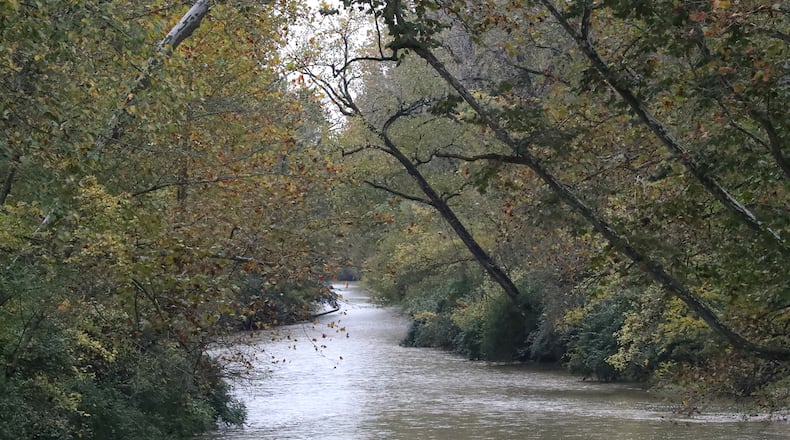Although saline levels have increased, Clark County officials said they haven’t had a chance to review the data.
“Anything that affects our water is worth monitoring,” said Clark County Utilities Director Chuck Bauer. “We’re committed to the protection of our source drinking water. Any activities that can prevent runoff from contaminating our ground water are a good thing.”
Clark County produces water for about 30% of its customers, Bauer said. The remaining 70% is purchased from other water systems such as Springfield, Enon and North Hampton.
Experts say elevated saline levels could affect the health of fish and plants in local rivers, could corrode water pipes, and someday could even release metals like lead into drinking water via that corrosion.
“It’s more something that we’re just looking at as a deviation from its normal background concentrations, but not really at a level where it would cause health concerns at this point,” said Richard Stuck, source water manager at Greater Cincinnati Water Works, one of the authors on a blog post noting the increases.
After the four agencies surveyed 70 wells in the area, 39 of them showed increasing trends in sodium and chloride levels, or at least periodic detections of elevated levels, according to the Miami Conservancy District.
The reason the salinity of the water is rising is due at least in part to the amount of road salt used on highways and roads, the Miami Conservancy District says, adding that there are ways to change that.
“Once the snow melts from the salt, that really salty water is pretty corrosive to metals and we worry that’s a potential threat,” said Mike Ekberg, manager of water resources monitoring and analysis at the Miami Conservancy District, who wrote about the increase in salt levels with Stuck.
What is increasing the salt levels?
Groundwater in the Miami Valley supplies water to an estimated 2.3 million people. The water that Miami Valley residents drink comes from the Great Miami Buried Aquifer. That aquifer is the water that moves between particles of dirt, stone and other earth underground.
Soil soaks up water from rain or other precipitation and carries all the impurities that might have washed into the groundwater with it to the aquifer and to the many rivers in the region.
Most communities in the Miami Valley use the aquifer as their source of drinking water in the region. Even off-grid well water taps into the Great Miami Buried Aquifer.
The Ohio Department of Transportation and other municipalities put a form of table salt on the roads to melt ice and snow in the winter. The salt people eat is in a more purified form.
When the snow melts, it brings the road salt with it into the soil, Ekberg said.
Among the other reasons cited for increased salt in groundwater were agricultural runoff and water softeners, with the agricultural issue more prominent in certain geographic areas.
Why is it harmful?
The water in the region is still safe for people to drink. But saltier water could cause problems in the water supply in the future, and could wreak havoc on the environment, the experts said.
Groundwater provides roughly 50% of the water that flows in the Great Miami River during a typical year, according to the Miami Conservancy District. So as the salinity of groundwater rises, so does the salt level of the Great Miami River.
Many fish, insects and plants depend on the water in the Great Miami River, Ekberg said. Some of those creatures and plants need the water to stay below a certain salinity level, or they won’t be able to survive.
“There’s a concern there that if that groundwater gets more and more salient, eventually, do we start to impact the fish, in the plant, the bug communities that live in the river,” Ekberg said.
As for threats to human health, Ekberg and other scientists are concerned about the saltier water eroding the pipes in the region. Corrosive groundwater can attack the insides of pipes, which can release high levels of metals like lead into drinking water.
Ekberg said in Flint, Michigan, the city changed the source of the water, and the water moving through the pipes was more saline. The water corroded pipes and released lead into the drinking water.
If salt in the water is so bad, can’t we just filter it out?
Ekberg said it’s not that simple. The available technology to remove salt from the water is expensive and requires a lot of energy. It’s easier to avoid getting too much salt in the water than trying to remove it later.
What can we do?
The best practice is just to salt the roads less in areas with less traffic, Ekberg said.
On highways, it makes sense to use salt and make sure that cars can get down the interstate safely. But Ekberg said that not all the salt applied is on highways. Sometimes it’s on parking lots near soccer fields and other spaces that aren’t used as much in the winter.
Ekberg said municipalities could also consider using less salt overall, especially near well fields, the places where there are several wells and cities source their water. The Miami Conservancy District can work with municipalities on that, he said.
“I think there’s a lot of places in and around well fields in the Miami Valley where if we were honest with ourselves, we could get by with very much reduced application or maybe we don’t even need to apply at all,” Ekberg said.
There are also new forms of treating roads that don’t require road salt, like cheese and pickle brine and de-sugared molasses.
Pre-treating roads with brine reduces the need for road salt.
The Consortium, a group of public water utilities and businesses that use groundwater in Butler County, reviewed and reduced the road salt application rate at a large parking lot near a wellfield, something that the Miami Conservatory District said is considered a best practice.
Bruce Whitteberry, assistant superintendent of the Water Quality Improvement Division at Cincinnati Waterworks, who is familiar with the research, said it’s not just the Miami Valley who is having issues with more saline water. Cities in northern Ohio, Minnesota and other northern U.S. states are also seeing more salt in their water.
“This is something that cities and municipalities have been looking at, and have had issues with nationwide,” Whitteberry said.



